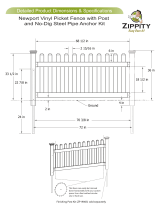
16
You can adjust any play of the miter gauge in
the table slot by tightening set screws (E).
Calibration
If a miter angle at the -45º, 90º or +45º is not
correct, the index stops can be adjusted by
turning one of three adjustment screws (D), then
locking the hex nut.
Note: Always make test cuts. Do not rely solely
on miter gauge indicator marks.
9.0 Electrical connections
The JPS-10TS table saw is rated at 115/230V
power, and is pre-wired for 115 volt. The table
saw comes with a plug designed for use on a
circuit with a grounded outlet that looks like the
one pictured in A, Figure 20.
Before connecting to power source, be sure
switch is in off position.
It is recommended that the table saw, when
operated on 115 volt power, be connected to a
dedicated 20 amp circuit with a 20 amp circuit
breaker or time-delay fuse marked “D”. When
operated on 230 volt power, it is recommended
that the table saw be connected to a dedicated
15 amp circuit with a 15 amp circuit breaker or
time-delay fuse marked “D”. Local codes take
precedence over recommendations.
9.1 Grounding instructions
1. All Grounded, Cord-connected Tools:
In the event of a malfunction or breakdown,
grounding provides a path of least resistance for
electric current to reduce the risk of electric
shock. This tool is equipped with an electric cord
having an equipment-grounding conductor and a
grounding plug. The plug must be plugged into a
matching outlet that is properly installed and
grounded in accordance with all local codes and
ordinances.
Do not modify the plug provided - if it will not fit
the outlet, have the proper outlet installed by a
qualified electrician.
Improper connection of the equipment-
grounding conductor can result in a risk of
electric shock. The conductor with insulation
having an outer surface that is green with or
without yellow stripes is the equipment-
grounding conductor. If repair or replacement of
the electric cord or plug is necessary, do not
connect the equipment-grounding conductor to a
live terminal.
Check with a qualified
electrician or service personnel if the
grounding instructions are not completely
understood, or if in doubt as to whether the
tool is properly grounded. Failure to comply
may cause serious or fatal injury.
Use only 3-wire extension cords that have 3-
prong grounding plugs and 3-pole receptacles
that accept the tool's plug.
Repair or replace damaged or worn cord
immediately.
2. Grounded, cord-connected tools intended for
use on a supply circuit having a nominal rating
less than 150 volts:
This tool is intended for use on a circuit that has
an outlet that looks like the one illustrated in A,
Figure 20. An adapter, shown in B and C, may
be used to connect this plug to a 2-pole
receptacle as shown in B if a properly grounded
outlet is not available. The temporary adapter
should be used only until a properly grounded
outlet can be installed by a qualified electrician.
This adapter is not permitted in Canada. The
green-colored rigid ear, lug, and the like,
extending from the adapter must be connected
to a permanent ground such as a properly
grounded outlet box.
3. Grounded, cord-connected tools intended for
use on a supply circuit having a nominal rating
between 150 - 250 volts, inclusive:
This tool is intended for use on a circuit that has
an outlet that looks like the one illustrated in D,
Figure 20. The tool has a grounding plug that
looks like the plug illustrated in D. Make sure the
tool is connected to an outlet having the same
configuration as the plug. No adapter is
available or should be used with this tool. If the
tool must be reconnected for use on a different
type of electric circuit, the reconnection should
be made by qualified service personnel; and
after reconnection, the tool should comply with
all local codes and ordinances.
Figure 20
9.2 Voltage conversion
To switch the incoming power leads for 230 volt
operation, follow the wiring diagram on the
inside cover of motor junction box. To access




















